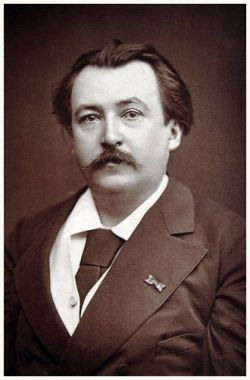Gustave Doré
Paul Gustave Doré (6 January 1832 – 23 January 1883) was a French artist, printmaker, illustrator, painter, and sculptor. He became one of the most celebrated illustrators of the 19th century, admired for his intricate wood engravings and interpretations of literature including works by Dante, Milton, Cervantes, and the Bible.
| Gustave Doré | |
|---|---|

| |
| Doré in 1867 | |
| Born | 6 january 1832 |
| Birthplace | Strasbourg, France |
| Nationality | French |
| Occupation | illustrator, painter, sculptor, printmaker |
| Known for | illustration, printmaking, painting, sculpture, and iconic book illustrations such as The Divine Comedy, Don Quixote, Paradise Lost, and The Rime of the Ancient Mariner |
| Website | https://en.wikipedia.org/wiki/Gustave_Dor%C3%A9 Gustave Doré on Wikipedia |
Early Life
Doré was born in Strasbourg, France, in 1832. From a young age, he showed remarkable talent in drawing and caricature. By the age of 15, he had moved to Paris, where his illustrations quickly caught the attention of publishers. His early works established him as a prodigy in the field of book illustration.
Career
Gustave Doré began his professional career as an illustrator for books and periodicals in Paris. His breakthrough came with commissions to illustrate literary classics, and his work soon gained international recognition. Publishers sought him out for his dramatic and detailed engravings, which became central features of many high-profile editions of European literature.
Doré’s art was not limited to illustration—he also worked as a painter and sculptor. However, it was his book illustrations that secured his reputation and widespread fame. His engravings allowed readers to visualize epic works with an intensity and grandeur unmatched in his era.
Gustave Doré Art
The phrase Gustave Doré art refers to the body of illustrations and engravings he created, which defined 19th-century book art. His style emphasized dramatic contrasts, sweeping landscapes, and expressive human figures. Today, his works are preserved in museums and libraries, and many remain in print as part of classic editions. Collectors and scholars continue to study Gustave Doré art for its influence on visual storytelling.
Paul Gustave Doré
While commonly referred to as Gustave Doré, his full name was Paul Gustave Doré. This name appears in official documents and art history records. Using his full name connects him to the broader tradition of 19th-century French artists, as he was not only an illustrator but also a painter and sculptor. Paul Gustave Doré is remembered as one of the most prolific artists of his generation.
Gustave Doré Paradise Lost
Among his greatest achievements was his illustrated edition of John Milton’s epic poem Paradise Lost. The series of engravings, often called Gustave Doré Paradise Lost, remains one of his most celebrated works. His illustrations brought Milton’s cosmic drama of heaven, hell, and the fall of man into a vivid visual form, filled with grandeur and intensity. This collection is still regarded as a masterpiece of literary illustration.
Jean Giraud et Gustave Doré
Art historians sometimes draw parallels between Jean Giraud et Gustave Doré due to their influence on visual culture. Jean Giraud, known as Moebius, was a 20th-century illustrator who transformed comic book art. Doré, a century earlier, had a similar impact on literary illustration. Both artists demonstrated extraordinary imagination, detail, and a unique ability to shape how stories are visualized.
Gustav Dora
In international references, Doré’s name is sometimes misspelled as Gustav Dora. Despite the variation, it is widely understood to refer to the French illustrator. This common error underscores the extent of his reputation, as his name traveled across languages and cultures, even when the spelling did not remain consistent.
Legacy
Gustave Doré’s legacy lives on through his engravings and illustrations, which remain among the most widely recognized images in Western art. His work has influenced not only painters and illustrators but also filmmakers, writers, and comic artists. Many of his engravings have been reprinted in modern editions of classic literature, ensuring that his vision continues to reach new audiences. Doré’s art is still considered an essential part of visual and literary history.
Selected Works
- The Divine Comedy (1861)
- Don Quixote (1863)
- Paradise Lost (1866)
- The Rime of the Ancient Mariner (1876)
- La Grande Bible de Tours (1866)
Death
Gustave Doré died in Paris on 23 January 1883 at the age of 51. He was buried in Père Lachaise Cemetery, where admirers continue to honor his contributions to art and literature.